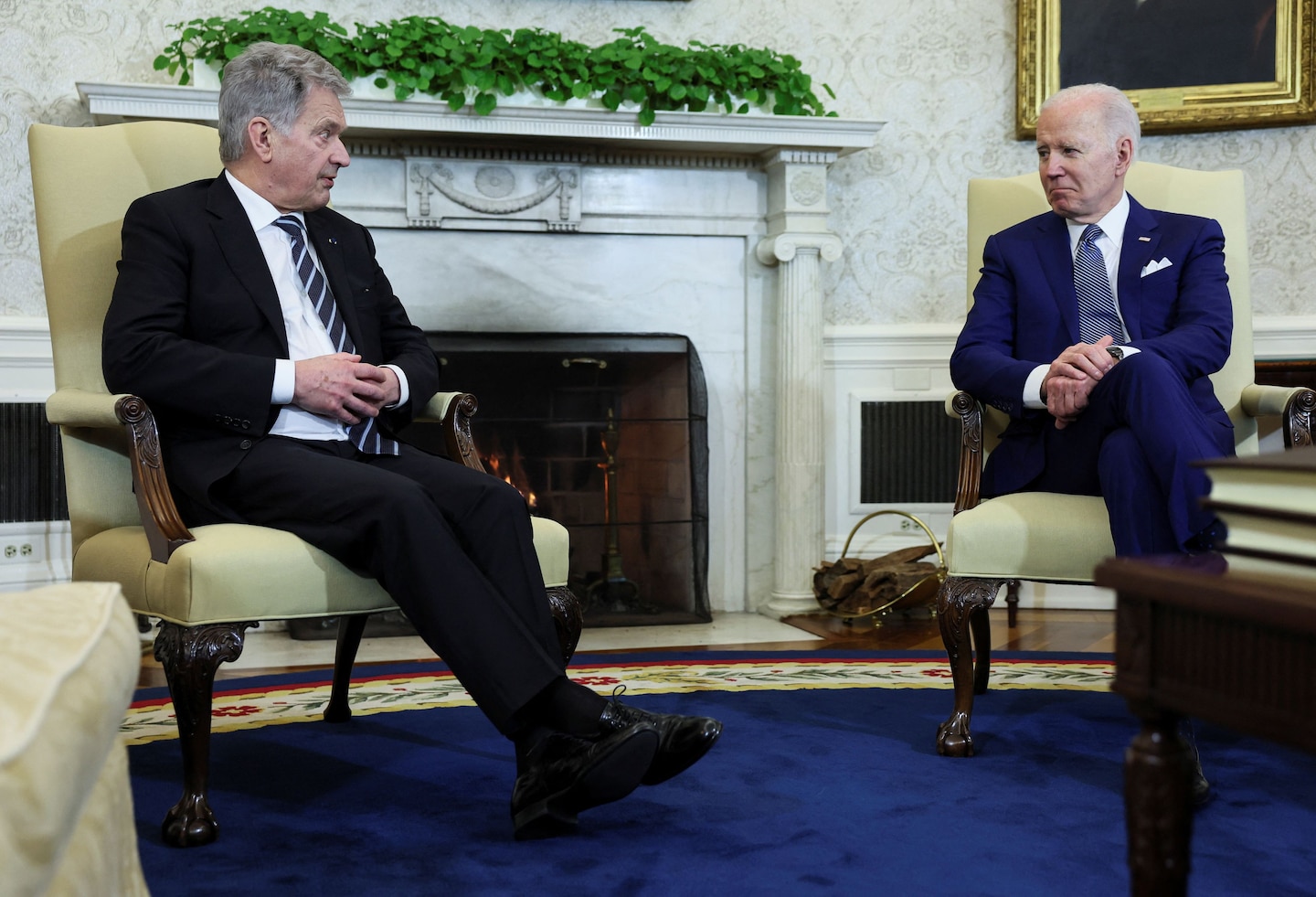Finland and Sweden weigh expanding Biden’s NATO ‘ring of freedom’ around Russia

“I find this absolutely astounding!” Biden exclaimed. He added during a red-faced 10-minute rebuttal, “If my friends are saying anyone who votes for expanding NATO to include Poland, the Czech Republic and Hungary are tying this noose around a Russian neck, this ‘iron ring,’ well, then I don’t quite get it.”
“I have the map, and I am looking at the map,” he said. “I am trying to figure where the ring is.”
“By the way — I happened to notice on the map — I don’t know that anybody is talking about Ukraine, including Ukraine,” Biden said. He added of Ukraine and Russia’s other nearer neighbors: “It seems to me they somehow sit between that ‘iron ring’ and that noble emerging democracy of Russia.”
Twenty-four years later, it’s become clear that wasn’t the beginning of “another 50 years of peace”; indeed, Russia has cited the expansion of NATO as a reason for its invasion of Ukraine, harking back to what the senators with whom Biden jousted warned about. But that same invasion is looking like it could in turn bring the ring — what now-President Biden said in 1998 was, in fact, a “ring of freedom” — even closer to Russia.
And not just through Ukraine.
While Russia’s invasion has injected new urgency into Ukraine’s desire for NATO membership, it has also brought the issue to the fore in two countries that have had better cases for membership but less desire to join: Sweden and Finland.
Both have long clung to their neutral stances, while maintaining good relations with both the West and Russia. But just as several other countries have felt compelled to pick sides and have sided with the West, both have suddenly and perhaps understandably seen a huge uptick in public support for NATO membership.
One poll in Sweden showed 51 percent of Swedes favored joining NATO, while just 27 percent opposed it. Support was up nine points from January, and it was the first time a majority of Swedes supported NATO membership.
Another poll of Finland, whose European border with Russia is second-longest behind Ukraine, found almost the exact same thing: 53-28 percent support, and an unprecedented majority. What’s more, the poll asked how people would feel if Sweden joined NATO, and support shot up to 66-20.
At the least, this threat would seem helpful to what remains of the effort to deter Russia; to the extent that its invasion is pushing countries toward NATO rather than away from it, that’s the opposite of what Russian President Vladimir Putin had in mind. Sweden and Finland are the only two Nordic-Baltic countries that are not in NATO. And were Finland and Ukraine to ultimately join NATO, Russia’s western border above the Black Sea would be all NATO countries except one: Belarus.
But it’s also worth asking just how much this public support might sustain itself and precede action.
Swedish Prime Minister Magdalena Andersson on Tuesday appeared to throw some cold water on the prospect, saying moving forward with an application for NATO membership right now would be “destabilizing.” That’s important because the party she leads, the center-left Social Democrats, is the biggest and most long-standing impediment to joining NATO. But it also seemed unlikely this would happen immediately, and Andersson’s comments don’t necessarily rule out looking at the issue in the future.
The differing approaches are noteworthy in that, as the poll in Finland suggested, it has long been conventional wisdom that Sweden would lead the way on something like this, said Stanley Sloan, a NATO scholar at the Atlantic Council.
“What has changed, obviously, is that public opinion has shifted to majorities in favor of membership,” Sloan said. “That makes an application less risky politically for leaders in both countries. In my opinion, given that both countries already have developed quite extensive cooperation with NATO, now is the time for them to make the move.”
Sloan said that while the processes differ by country, he expected both would be approved relatively quickly.
Sean Monaghan, a European defense expert at the Center for Strategic and International Studies, said it was “not unlikely” that either or both countries would wind up joining NATO. Finland’s moves are particularly interesting, Monaghan said, in that it tends not to be fickle about such things. He suggested its own experience with war against the Soviets informs what we’re seeing today.
“For the Finns, the 1939 Winter War — which is central to their national identify and strategic culture — may be weighing heavily on them,” Monaghan said. “They suffered the same fate as the Ukrainians are now, and resisted just as fiercely. As well as empathy and sympathy, there may be a sense of history repeating itself.”
A big unknown in all of this is just what’s going on behind the scenes — and how hard Biden himself might be pushing this. On Friday, when Finnish President Sauli Niinistö visited the White House, neither he nor Biden addressed NATO in their brief public comments. But Monaghan said, “You can bet they were sounding out the U.S. on potential NATO membership.”
The public U.S. posture on these things tends toward support — but support for what those countries want to do themselves. U.S. leaders don’t want to be seen as being heavy-handed; they want NATO applications to be something the countries have decided to do themselves.
With Finland and Sweden now trending in that direction, Biden has a real chance, if he wants it, to expand his “ring of freedom,” nearly a quarter-century hence — and indeed, to bring it close to Russia in a way Biden himself noted in 1998 wasn’t so imminent. For all involved, of course, that must be measured against Russia viewing it as the iron ring Biden’s colleagues warned of — a prospect that at least Sweden seems acutely concerned about.






